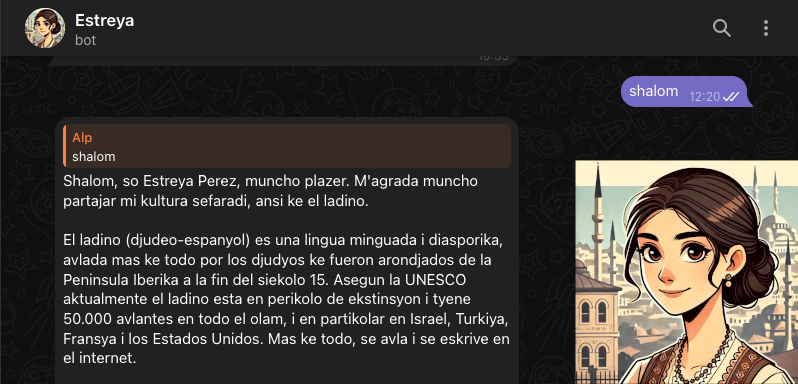Can LLMs Help Revitalize an Endangered Language?

Can LLMs help revitalize an endangered language? That’s exactly what we’re exploring in my latest collaboration creating a chatbot that speaks and helps practice Ladino: Estreyika Perez.
Today marks her launch and you can listen to our conversation with the Estreyika team and see her capabilities in action. I’m delighted to see this becoming reality as this represents a major leap from when we first created the automatic translator for Ladino in 2022. Seeing fluent conversations happening to help people practice this severely endangered Judeo-Spanish language (UNESCO lists only ~50,000 speakers worldwide) is incredible progress!
From Skepticism to Success
When Dr. Carlos Yebra López first contacted me with his idea, I really thought this wouldn’t be possible but gave it a chance thinking our rule-based translator would help. The challenge seemed immense - how could we create a conversational AI for a language with such limited digital resources?
At the end, it turns out that modern LLMs know at least something of Ladino and with the right optimization and linguistic knowledge push, we can obtain a compelling conversational experience. This discovery opened up possibilities we hadn’t initially imagined.
Building on Digital Foundations
This breakthrough is thanks to both technological advancements of LLMs, but beyond that, the amazing work by linguists and activists who’ve built Ladino’s digital presence over the years. Our previous work on machine translation and text-to-speech synthesis for Ladino, published in “Preparing an Endangered Language for the Digital Age”, laid crucial groundwork for this project.
The technical challenge was significant. Unlike our MT project where we could build rules to translate from one language to another, a real conversation requires a deep understanding of cultural context, authentic language use, and the ability to maintain character consistency throughout extended dialogues. This is now possible with the advent of LLMs but still we had to carefully craft prompts to ensure Estreyika doesn’t fall into “Spanishisms” - using Spanish grammar patterns or vocabulary that would feel inauthentic to native Ladino speakers - or provide inaccurate information.
Community Response and Cultural Authenticity
The feedback from students and the community has been remarkable - many praising Estreyika’s authenticity in Ladino, her captivating personality, and her genuine enthusiasm that makes learning feel like chatting with a knowledgeable friend from 19th century Istanbul.
What strikes me most about the user feedback is how Estreyika manages to embody not just the language, but the cultural essence of Sephardic heritage. Students report feeling emotionally connected to the conversations, learning not just vocabulary but traditions, recipes, and historical context that brings the language to life.
The Path Forward
This is just a pilot, but it validates our approach. Thrilled to continue pushing the boundaries of what’s possible when AI meets language revitalization. The success of Estreyika demonstrates that even severely endangered languages can benefit from modern language technology - not to replace human speakers, but to create new pathways for cultural transmission and learning.
Try Estreyika Yourself
🎥 Watch the full presentation with demo: YouTube
💬 Chat with Estreyika: Telegram Bot